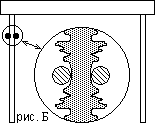.
DISTANT IMPACT
4.4. PSYCHOKINESIS and UNIVERSAL FIELD©
è
Existence of DP, and especially of psychokynetic phenomena, which –
• undoubtedly exist, for they
• not only are registered /proveâ to be true by physical methods,
• but also are directly observed as physical processes/events, and at that
• contradict laws of physics –
forces to reconsider raising (in particular by A. Einstein, 1879-1955) a question of the universal field theory search, which is devoted (i.e. should be devoted) to provide mastering (understanding and using on the basis of this understanding) universal laws (causal relationships) of nature – space-temporal, substance-energy, etc., in particular – gravitational.
Existence of DP forces to attitude to these nature laws as to the hyperphysical, i.e. to expand sphere of search, to expand it out of the limits of physics (more correctly – of physicum), forces to take into account laws physical together with metaphysical ones, in particular – with the informational.
The most convincing for the author precedents of psychokynesis reality (excluding, maybe, the cases of own experience – see section 1.5) are the cases published by A.M. Butlerov/Áóòëåðîâ [ 20 ]. He has described, for example, disappearance of a bracelet from a woman's hand during a spiritualistic session. After the session it has been found out on a figured leg of a table (at which the session was carried out) in that place, from which it could not be removed (be taken off without having damaged/injured – see fig. Б) and where, accordingly, it could not be placed by "natural"/physical ways.
At other sessions things' weight changed in times (both increased and reduced - under the orders of the sessions participants). Butlerov as a chemist was skilful to use balances. In this case the statement of Einshtein's GTR (the General Theory of Relativity) about gravitation as about crooking of space by a weight locating/existing in it, is useless (for during a session the used things' weight did not change, as well as the Earth's weight). Moreover, this statement is initially internally contradictory.
| |  |
There are not rare cases in science history when conclusion, which are quantitatively confirmed with facts, have been get form obviously false assumptions [Sergey I. Vavilov/Ñåðãåé Èâàíîâè÷ Âàâèëîâ].
A curvature of n-dimensional space (whether by weight or other agent) is possible in space of at least ( n+1 ) dimensions. A line, one-dimensional space ( n = 1 ), can be crooked in at least a plane ( n = 2 ) and as a part of this plane; a bidimentional space (a plane) can be curved in volumetric space ( n = 3 ), as its part. To curve the 3-dimensional space, it is necessary, accordingly, that it would be a part of at least 4-dimensional space. Meanwhile, the GTR concept doesn't mean a space, more than of 3 dimensions. The 4-dimensional space is considered in it as space-and-time continuum.
Introduction (in addition after A.Einstein) of the fourth space dimension (or of several additional dimensions) cannot change (rescue) the situation, give fruitfulness to the idea of space crooking.
Space is metaphysical.
A mass, as a lifeless object, cannot influence actively (as it is shown later, in section 7.4) upon metaphysicum, upon its elements (in particular to curve them).
Time is metaphysical too (as space).
Thus, introduction (by A. Einstein) of the term space curvature is proved to be only a formal substitution of the term gravitation, only play with words, attempt to explain one not clear notion by means of another, no more clear.
Such a logic mistake happens in the special psychological literature so frequently, that one may speak it is typical one. It concerns not (only) scientists-beginners. So, venerable psychologists defined:
• Carroll E. Izard – concept of emotion as result of changes in nervous system... (1923, the Russian edition – 1980, [ 46 ]);
• P.P. Blonsky/Ï.Ï. Áëîíñêèé – concept of anamnesis through reintegration (1964, [ 13 ]);
• P.Ja. Galperin/Ï.ß. Ãàëüïåðèí – concept of attention through control (1974, [ 24 ]);
• according to Sh.N. Chkhartishvili/Ø.Í. ×õàðòèøâèëè – activity of will is submitted in consciousness as experience of will - willing (1955, [ 139 ]).
• Sigmund Freud (Sigismund Schlomo F., 1856-1939) fits this list quite well too. However . . .
The psychological essence (an inner reason) of such an attempt is clear;denomination of some incomprehensible creates an illusion of clearness. Sometimes – in a fiction, in household speech, in pedagogical practice – it happens to be expedient, but only not in strict, fundamental science. The science begins, when word meanings are precisely differentiated (L. Brilljuen, 1960, [ 17 ]).
|
GTR identifies speed of information transfer with speed of light (in vacuum), actually – with speed of the signal carrying this information. At such an approach existence of "involved" particles, fact of synchronous change of their properties (or parameters, e.g. their impulses), irrespective of distance between them, seems to be paradoxical/inexplicable. The phenomenon is even named as paradox (a Einstein-Podolsky-Rosesn paradox; the author's attention was turned to this by K.N. Mhitarjan). The same fact (of non-local interactions) ceases to be paradoxical one at the hyperphysical approach to it: information as the non-physical hypersubstance (as a kind of a matter) exists outside of space; it is the same that information exists simultaneously in all areas/points of space.
è

